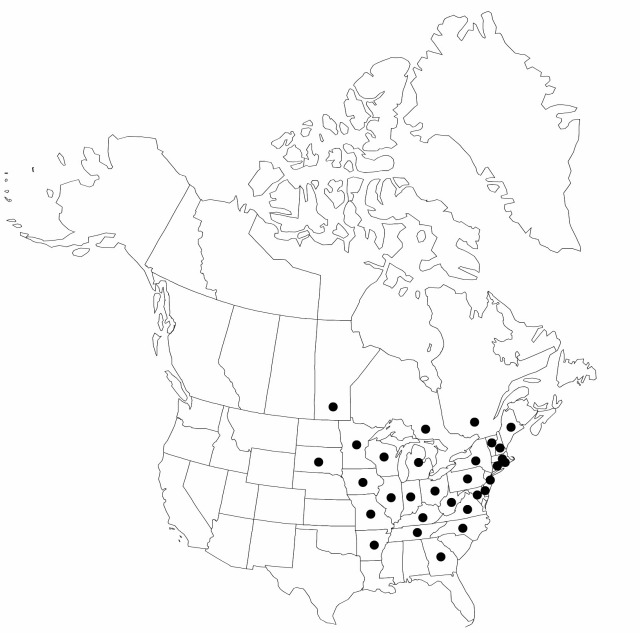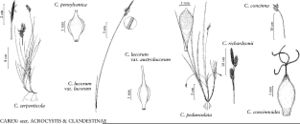Carex pensylvanica
in J. Lamarck et al., Encyl. 3: 388. 1792.
Plants loosely cespitose; rhizomes horizontally spreading, reddish-brown to dark-brown, (10–) 40–100 mm, slender. Culms 10–45 cm, smooth to weakly scabrous distally; bases (remnants of old leaves) slightly fibrous. Leaf-blades green, 0.5–3.6 mm wide, herbaceous, papillose to scabrous abaxially, papillose to scabrous adaxially, blades of distal cauline leaves well developed. Inflorescences usually with both staminate and pistillate spikes; peduncles of staminate spikes 0.1–7.5 mm; proximal cauline bracts leaflike, usually shorter than inflorescences. Spikes: proximal pistillate spikes 1–3 (–4) (basal spikes 0, rarely 1); cauline spikes overlapping or separated, with (3–) 4–13 perigynia; staminate spikes 8–24 × 1.3–4 mm. Scales: pistillate scales dark reddish-brown, with narrow white margins, ovate, 2–4 × 1.3–2.8 mm, equaling perigynium body, apex obtuse or acute to acuminate; staminate scales elliptic to ovate, 2.9–5.3 × 1.1–1.9 mm, apex obtuse or acute to acuminate. Anthers 1.8–4 mm. Perigynia pale green, veinless, obovoid, 2.2–3.4 × 1.1–1.5 (–1.7) mm; beak straight, pale green, 0.5–0.9 mm, weakly ciliate-serrulate, apical teeth 0.1–0.4 mm. Stigmas 3. Achenes dark-brown, obovoid, obtusely trigonous in cross-section, 1.3–2.3 × 0.9–1.4 (–1.6) mm. 2n = 36.
Phenology: Fruiting early May–late Jul.
Habitat: Well-drained, acidic but cation-rich, sandy, rocky, and loamy soils under hardwood forest canopies, forest edges, savannas, “balds” and in rocky or sandy openings
Elevation: 150–1500 m
Distribution

Man., Ont., Que., Ark., Conn., Del., Ga., Ill., Ind., Iowa, Ky., Maine, Md., Mass., Mich., Minn., Mo., N.H., N.J., N.Y., N.C., Ohio, Pa., R.I., S.Dak., Tenn., Vt., Va., W.Va., Wis.
Discussion
Selected References
None.
Lower Taxa
"shortened" is not a number.
